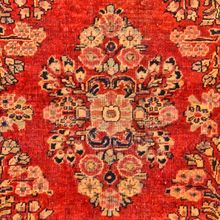MoshkAbad Rug
| MoshkAbad Rug | |
|---|---|
 Design of MoshkAbad Rug (Rugman) | |
| General information | |
| Name | MoshkAbad Rug |
| Original name | قالی مشکآباد |
| Alternative name(s) | MoshkAbad Carpet |
| Origin | |
| Category | Village |
| Technical information | |
| Common designs | Vagireh, Medallion |
| Common colors | Blue, Green, Brown, Red, Yellow, Navy Blue |
| Dyeing method | Natural, Synthetic |
| Pile material | Wool |
| Foundation material | Cotton |
| Knot type | Asymmetrical (Persian) |
Moshkabad rugs are hand-woven by semi-nomadic people living in the village of Moshkabad, near Arak in north-western Iran. The central fields usually have a warm floral-patterned medallion, and the colors are very warm and lively. However, geometric patterns are sometimes used, and many other colors besides red can be found. Obvious traces of Kurdish origins are evident in these rugs.
History
Moshkabad village is located in the Arak (Markazi) Province of west central Iran. Moshkabad carpets are known in the market from the turn of the twentieth century.
The carpet designs are semifloral in either all-over or medallion styles. Designs employed were the palmette with leaves and vines, Harshang (crab), Herati (fish), Minakhani (rosette-linked trellis), Maighan, and the Open Field pattern. Earlier medallion carpets had mostly a lozenge-shaped center motif.
Moshkabads followed the pattern styles of Mahal or Mahallat, but in a lower grade quality. The weavers from this village produced large quantities of rugs for low-budget consumers both domestically and abroad. Nearby villages such as Davodabad, Einabad, and Kerdabad marketed their carpets as Moshkabad in the trade.
Formats range from small mats to large room-size carpets. The weavings are generally low to medium in overall grade quality. They have a cotton foundation and a wool pile. The Persian (asymmetric) knot is universally used.
The weavings usually have a brick- or rust-red background; ivory and dark blue are also used for the field and borders. Besides these colors, different shades of red, blue, green, gold, brown, cinnamon, and gray accentuate the design elements and guard borders. Dark blue or dark brown is employed for design outlines.
By the last quarter of the twentieth century, some Moshkabad weavers switched from their usual designs to make carpets similar to those of other cities and villages in the region in accordance with the demand of domestic and foreign consumers.[1]
See also
| Search for MoshkAbad Rug on Wikipedia. |
References
- ↑ Moheban, 2015, 409
Bibliography
- Abraham Levi Moheban. 2015. The Encyclopedia of Antique Carpets: Twenty-Five Centuries of Weaving. NewYork: Princeton Architectural Press.